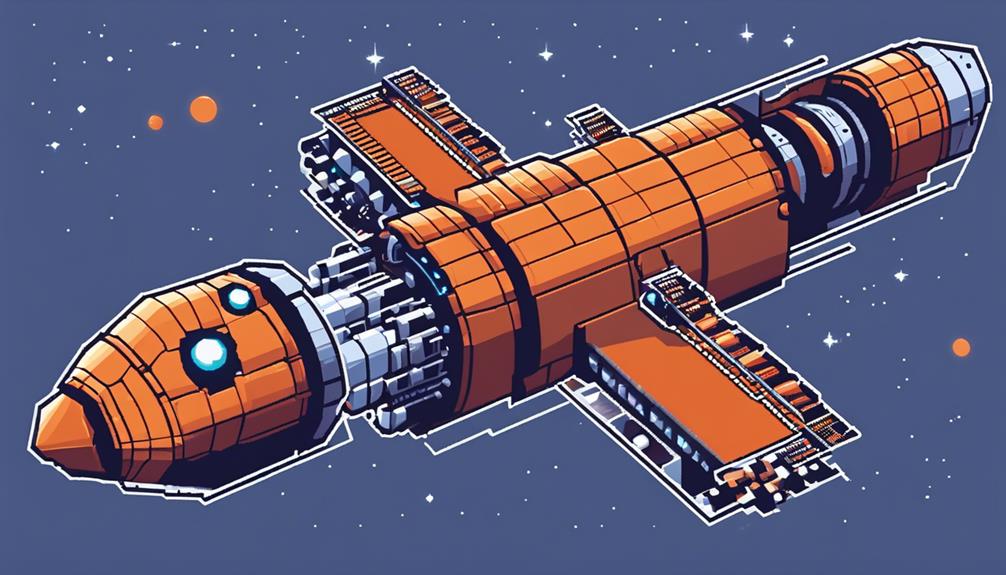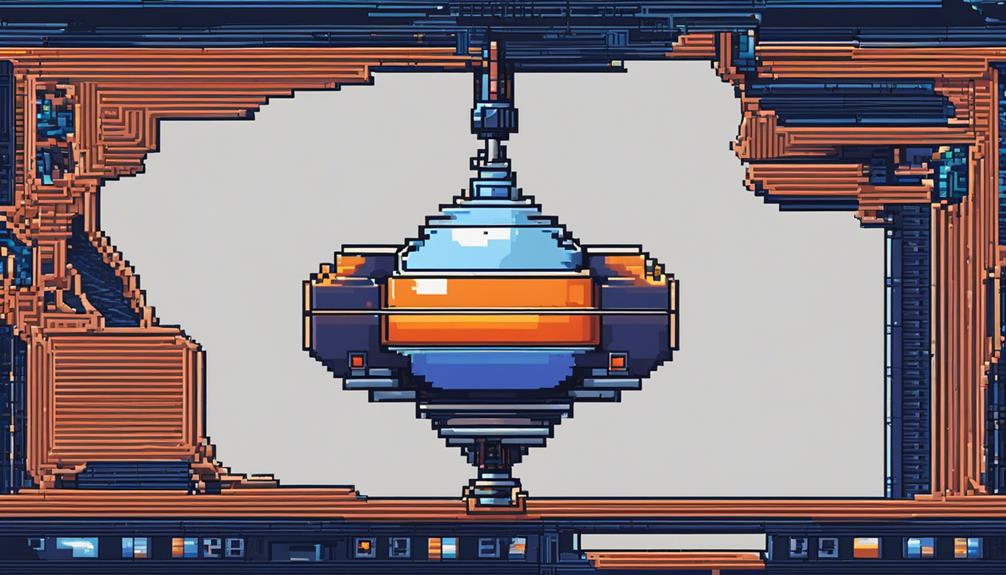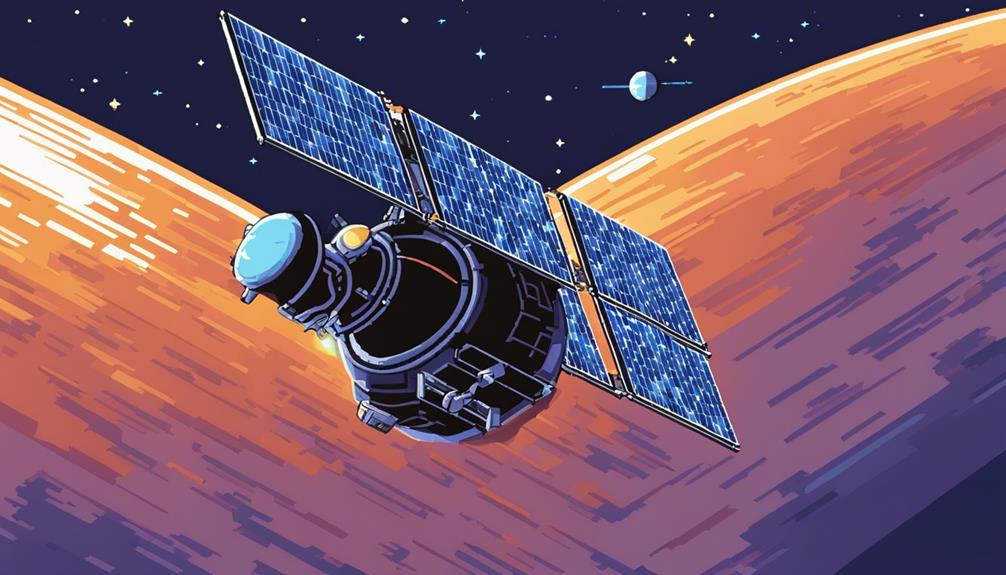Advancements in satellite propulsion systems have been pivotal in redefining the possibilities of space exploration. From Electric Thrusters to Magnetoplasmadynamic Thrusters, a spectrum of cutting-edge technologies is propelling us towards a new era of interplanetary travel. The quest for faster, more efficient propulsion methods continues to intrigue scientists and engineers alike, promising breakthroughs that could revolutionize our understanding of the cosmos. These developments not only hold the key to reaching distant celestial bodies but also pave the way for unprecedented feats in space exploration.
Key Takeaways
- Electric and plasma propulsion systems revolutionize satellite efficiency.
- Ion thrusters and PPTs offer precise control and extended mission capabilities.
- VASIMR technology enhances interplanetary missions and crewed Mars missions.
- Solar electric propulsion ensures sustainability and high efficiency for deep space exploration.
Electric Thrusters

Electric thrusters are advanced propulsion systems that utilize electrical energy to accelerate ions or neutral particles for spacecraft propulsion. These electric propulsion systems are known for being highly fuel-efficient compared to traditional chemical propulsion systems, making them ideal for long-duration missions such as deep space missions. The efficiency of electric thrusters stems from the fact that they can operate for extended periods, providing continuous thrust. This continuous thrust allows for precise maneuvering and station-keeping in space, essential for satellite operations and deep space exploration.
In the realm of electric propulsion systems, ion thrusters stand out as a prominent example. Ion thrusters generate thrust by ionizing propellant gas and accelerating the ions using electrostatic forces. This technology has been pivotal in enabling spacecraft to reach distant destinations efficiently and with a high degree of precision. Ion thrusters are particularly well-suited for deep space missions where traditional propulsion systems would fall short in terms of efficiency and longevity.
Ion Thrusters
Ion thrusters are advanced propulsion systems that utilize electric fields to accelerate ions, providing high specific impulse and fuel efficiency. These thrusters find extensive applications in space missions, offering precise spacecraft maneuvers and enabling long-duration operations. Their efficiency and versatility make them a key technology for satellite propulsion breakthroughs.
Efficiency of Ion Thrusters
Utilizing advanced propulsion technology, ion thrusters excel in efficiency through electric propulsion by ionizing gas. These thrusters offer exceptional fuel efficiency and extended mission durations, making them a preferred choice for spacecraft requiring prolonged operations. With their high specific impulse, ion thrusters enable spacecraft to achieve greater speeds while conserving propellant, enhancing overall mission capabilities. Ideal for missions necessitating precise maneuvers, such as station-keeping in geostationary orbit or fine adjustments during interplanetary travel, ion thrusters have been instrumental in various space applications. Their ability to provide low thrust levels for extended periods sets them apart, making them a reliable propulsion system for a wide range of space missions.
Applications in Space
In the realm of space applications, ion thrusters play a pivotal role in facilitating station-keeping, orbit adjustments, and attitude control in satellites. Ion thrusters offer efficient propulsion through the acceleration of ions using electric fields. Key applications of ion thrusters include:
- Station-keeping: Ion thrusters help satellites maintain their position in orbit by providing precise and continuous low thrust.
- Orbit adjustments: These thrusters enable satellites to make controlled changes to their orbits, ensuring optimal positioning for various mission requirements.
- Attitude control: Ion thrusters contribute to stabilizing and adjusting the orientation of satellites, enhancing their operational capabilities for long-duration missions.
Utilizing xenon gas as propellant, ion thrusters have revolutionized satellite propulsion by offering fuel-efficient solutions for extended space missions.
Plasma Propulsion Systems

Plasma propulsion systems harness the power of electrically charged gas to propel satellites in space missions with increased efficiency and specific impulse. These systems utilize plasma, an electrically conductive state of matter, to generate thrust, offering significant advantages over traditional chemical propulsion methods. The higher specific impulse and efficiency of plasma propulsion systems make them ideal for long-duration missions requiring precise maneuvering capabilities. Hall-effect thrusters, a common type of plasma propulsion system, are widely used in satellites for their reliability and performance.
| Plasma Propulsion Systems | Advantages |
|---|---|
| Utilize electrically charged gas | Higher specific impulse |
| Offer increased efficiency | Enable precise satellite maneuvering |
| Utilize Hall-effect thrusters | Enhance satellite performance |
| Ideal for long-duration missions | Improve mission capabilities |
| Enable reliable propulsion in space | Optimize satellite operations |
These systems have revolutionized satellite propulsion technology, paving the way for enhanced satellite performance and expanded mission capabilities. Continued advancements in plasma propulsion systems aim to further improve efficiency and thrust capabilities, ensuring the continued evolution of satellite propulsion technology for future space exploration endeavors.
Hall Effect Thrusters
Hall Effect Thrusters utilize electromagnetic forces to propel ions for efficient satellite propulsion in long-duration missions. These electric propulsion systems have gained popularity in the aerospace industry due to their high specific impulse and fuel efficiency. Here are some key points regarding Hall Effect Thrusters:
- Efficient Propulsion: Hall Effect Thrusters are known for their high specific impulse, which is a measure of how effectively propellant is converted into thrust. This efficiency is crucial for long-duration missions where conserving fuel is essential.
- Ideal for Geostationary Satellites: These thrusters are particularly well-suited for geostationary satellites, where precise station-keeping and orbit adjustments are required. The ability of Hall Effect Thrusters to provide continuous low thrust makes them ideal for maintaining the position and orientation of satellites in geostationary orbits.
- Operational Advantages: Hall Effect Thrusters have been successfully utilized in both commercial and scientific satellites for various maneuvers, including orbit raising and attitude control. By extending the operational lifespan of satellites and reducing the need for frequent refueling missions, these thrusters play a crucial role in satellite propulsion technology.
Variable Specific Impulse Magnetoplasma Rocket (VASIMR)

Utilizing advanced radio wave technology, the Variable Specific Impulse Magnetoplasma Rocket (VASIMR) represents a cutting-edge electric propulsion system designed to enhance spacecraft maneuverability and accelerate interplanetary travel. Developed by the Ad Astra Rocket Company, VASIMR functions by ionizing propellant through radio waves to create a superheated plasma that is expelled at high velocities to generate thrust. This innovative technology has the potential to revolutionize deep space exploration by significantly reducing travel times for interplanetary missions.
One of VASIMR's key features is its variable specific impulse, which enables spacecraft to efficiently accelerate and decelerate during different phases of a mission. This flexibility in thrust management enhances mission adaptability and enables precise trajectory adjustments, making it ideal for crewed missions where safety and efficiency are paramount concerns. The high specific impulse offered by VASIMR not only accelerates spacecraft to high speeds effectively but also provides the versatility required for complex maneuvers in deep space environments.
With its promising capabilities, VASIMR is being considered for future crewed missions to Mars and beyond, where its efficiency and maneuverability could significantly reduce mission durations and enhance overall mission success. The adaptability and high performance of VASIMR make it a leading candidate in the realm of electric propulsion for advanced interplanetary missions.
Pulsed Plasma Thrusters
Pulsed Plasma Thrusters (PPTs) represent a significant advancement in satellite propulsion technology, offering high efficiency and precise control in maneuvering spacecraft. The future applications of PPTs in small satellites and spacecraft hold promise for enhancing mission capabilities and reducing overall mission costs. Recent advancements in PPT technology have focused on improving thrust performance and optimizing fuel efficiency for prolonged space missions.
Efficiency of PPTs
The efficiency of Pulsed Plasma Thrusters (PPTs) in small satellite propulsion systems is a critical factor contributing to their widespread adoption in space missions. PPTs offer significant advantages due to their high specific impulse and precise control capabilities, making them well-suited for various tasks such as station-keeping and attitude control. Key reasons why PPTs are preferred in small satellite propulsion systems include:
- High Specific Impulse: PPTs provide high specific impulse, resulting in efficient fuel consumption and extended mission durations.
- Compact Size: The compact design of PPTs allows for easy integration into small satellites without compromising on propulsion power.
- Low Power Requirements: PPTs operate efficiently with low power consumption, making them ideal for small satellite missions with limited power resources.
Future Applications
Pioneering advancements in satellite propulsion technology are poised to leverage the capabilities of Pulsed Plasma Thrusters towards innovative future applications. These applications may include enabling extended mission capabilities and orbital adjustments for satellite constellations. Pulsed Plasma Thrusters offer precise attitude control and efficient propulsion, making them ideal for small spacecraft missions. Their low power requirements and lightweight design are well-suited for CubeSats and nanosatellites. The table below highlights the key features and benefits of Pulsed Plasma Thrusters for future applications:
| Feature | Benefit | Application |
|---|---|---|
| Precise attitude control | Enables accurate orbital maneuvers | Satellite constellations |
| Extended mission capabilities | Prolongs satellite lifespan | Small spacecraft missions |
| Efficient propulsion | Low power consumption | Precise orbital adjustments |
Advancements in Technology
Advancing the capabilities of satellite propulsion technology, recent developments in Pulsed Plasma Thrusters have focused on enhancing thrust density and operational longevity for improved satellite maneuverability. Pulsed Plasma Thrusters (PPTs) utilize electric fields to accelerate plasma, providing efficient and lightweight propulsion for small satellites. The advancements in PPT technology aim to increase thrust density, allowing for more powerful propulsion within the constraints of small satellite designs. Operational lifespan improvements in PPTs ensure prolonged functionality, contributing to the extended maneuvering capabilities of satellites in orbit. These advancements in Pulsed Plasma Thrusters play a crucial role in enhancing the precision and flexibility of satellite propulsion systems, particularly in the context of small satellite missions.
Key Points:
- Enhanced thrust density for more powerful propulsion.
- Improved operational lifespan for prolonged functionality.
- Increased precision and flexibility in satellite maneuvering.
Colloid Thrusters
Utilizing a liquid propellant that forms a colloidal suspension, colloid thrusters are at the forefront of propulsion technology for small satellites, offering high efficiency and precise thrust control. These thrusters operate by ejecting charged droplets to generate thrust in a controlled manner, making them ideal for the precise maneuvers required in space missions. Due to their compact size and low power consumption, colloid thrusters are well-suited for small satellites, enabling these spacecraft to perform various tasks efficiently.
| Feature | Description | Benefit |
|---|---|---|
| High Efficiency | Colloid thrusters offer efficient propulsion, | Maximize mission capabilities |
| ensuring spacecraft can achieve desired goals | ||
| Precise Thrust Control | Ability to finely adjust thrust levels | Enhance maneuverability in space |
| Compact Size | Small footprint allows integration into small | Enable deployment in limited spaces |
| Low Power Consumption | Energy-efficient operation for extended missions | Prolong satellite lifespan |
Research and development efforts in colloid thruster technology continue to focus on enhancing maneuverability and mission capabilities for small satellites. By advancing the capabilities of colloid thrusters, scientists and engineers aim to unlock new possibilities for small spacecraft, enabling them to undertake complex missions with precision and efficiency in the vast expanse of space.
Electrospray Propulsion

Electrospray propulsion systems excel in efficiently accelerating ions for precise satellite maneuvering. These miniaturized propulsion units offer a high degree of control, facilitating intricate orbital adjustments. The technology's precision control mechanisms ensure optimal efficiency in satellite operations.
Efficient Ion Acceleration
Ion acceleration technology in satellite propulsion has seen significant advancements with the development of efficient electrospray propulsion systems utilizing ionic liquid propellants. These systems offer high specific impulse, making them ideal for satellite maneuvers requiring precision and efficiency. Additionally, electrospray thrusters enable fine attitude adjustments, crucial for satellite stabilization in orbit. In comparison to traditional propulsion systems, electrospray technology provides lightweight solutions that are particularly beneficial for NanoSatellites. Moreover, the scalability of electrospray technology allows for customization to meet the specific needs of satellites of various sizes and mission requirements.
Key Points:
- Electrospray propulsion offers high specific impulse for efficient ion acceleration.
- Field-emission electric propulsion systems provide precise thrust control for satellite maneuvers.
- Electrospray thrusters enable fine attitude adjustments for satellite stabilization.
Miniaturized Propulsion Systems
Advancing the realm of satellite propulsion, miniaturized propulsion systems have emerged as a cutting-edge technology in the form of Electrospray Propulsion. These systems utilize ionic liquid propellants to provide precise and efficient thrust at low levels, making them ideal for attitude control and maneuvering in small spacecraft. Electrospray propulsion is highly efficient and scalable, catering to CubeSats and small satellite missions. It enables precise orbital adjustments and station-keeping maneuvers, crucial for extended mission durations. Moreover, these systems are known for their low power consumption, further enhancing their suitability for small satellite applications. Electrospray propulsion represents a significant advancement in propulsion technology, offering a sophisticated solution for the propulsion needs of modern miniaturized satellites.
Precision Control Mechanisms
Precision control mechanisms in satellite propulsion play a crucial role in enabling intricate orbital adjustments and station-keeping maneuvers for small spacecraft missions. Electrospray propulsion systems utilize ionic liquid to generate thrust with exceptional precision control, making them ideal for maintaining satellite positions. The thruster capabilities of electrospray technology allow for efficient station-keeping and formation flying in space. These systems offer not only efficiency but also accuracy, making them increasingly popular for small satellites requiring delicate propulsion adjustments. The gentle yet accurate nature of electrospray propulsion provides a significant advantage in achieving precise orbital maneuvers, contributing to advancements in satellite propulsion technology.
Microwave Electrothermal Thrusters

Microwave electrothermal thrusters represent a significant advancement in propulsion technology, particularly due to their utilization of water as a propellant source. Momentus, a company specializing in satellite propulsion systems, is currently developing a microwave electrothermal thruster system that relies on water as the propellant of choice. This innovative approach offers efficient propulsion capabilities, showcasing the potential for water to play a crucial role in future space missions.
ThrustMe, another key player in the field of propulsion technology, recently achieved a milestone by successfully conducting on-orbit tests of an electric propulsion system fueled by iodine. While this specific system differs from the water-propelled microwave electrothermal thrusters, the overall trend towards environmentally friendly and high-performance propulsion solutions is evident in both cases.
The utilization of water as a propellant source not only demonstrates a sustainable approach to space travel but also contributes to improved thrust and efficiency in propulsion systems. These advancements are crucial for enhancing the operational lifespan of satellites in low Earth orbits, further underlining the importance of continuous innovation in the field of satellite propulsion. As research and development in microwave electrothermal thrusters progress, the potential for even greater efficiency and performance in space missions continues to grow.
Resistojet Thrusters
The utilization of resistojet thrusters in satellite propulsion systems represents a reliable and efficient method of expelling a working fluid for precise maneuvering and control in space missions. These thrusters play a crucial role in maintaining the position and adjusting the orbit of satellites with high accuracy and efficiency. Key characteristics of resistojet thrusters include:
- Efficiency: Resistojet thrusters are known for their efficiency in utilizing power to heat the working fluid, typically a propellant like water, ammonia, or hydrazine. This process generates thrust efficiently, making them suitable for station-keeping tasks where precision is paramount.
- Station-Keeping: Resistojet thrusters are commonly employed for station-keeping activities in satellites. By precisely controlling the expulsion of the working fluid, these thrusters enable satellites to maintain their position and orientation in space, ensuring optimal performance and functionality.
- Reliability: Due to their simple design and operation, resistojet thrusters offer a reliable propulsion solution for satellites. They have a long operational lifespan and are well-suited for continuous thrusting to make necessary adjustments for station-keeping purposes. Their reliability makes them a preferred choice for various satellite missions that require consistent and accurate propulsion capabilities.
Solar Electric Propulsion

Utilizing solar panels to harness electricity for ion thrusters, solar electric propulsion systems offer a highly efficient and sustainable method for providing continuous thrust in long-duration space missions. These systems have gained prominence in the field of satellite propulsion due to their fuel-efficient nature and cost-effectiveness, particularly in deep space exploration missions where traditional chemical propulsion methods fall short.
One of the key advantages of solar electric propulsion is its ability to generate thrust over extended periods, allowing spacecraft to reach distant destinations efficiently. By converting solar energy into electrical power, ion thrusters ionize propellant and expel the ions at high speeds, producing a gentle but continuous acceleration that can significantly reduce travel time for interplanetary missions.
NASA's Dawn spacecraft exemplifies the successful application of solar electric propulsion, utilizing this technology to explore Vesta and Ceres in the asteroid belt. Compared to conventional propulsion systems, solar electric propulsion offers higher specific impulse and lower propellant mass requirements, making it an attractive option for missions requiring prolonged operation in space.
Gridded Ion Thrusters
Leveraging a sophisticated system of electrodes, gridded ion thrusters propel satellites with efficient and precise low-thrust propulsion capabilities. These thrusters function by ionizing propellant gas, typically xenon, and accelerating the ions using electric fields created by the grids of electrodes.
Key Points:
- Efficient Propulsion:
Gridded ion thrusters are known for their high efficiency due to the ionization and acceleration process that generates thrust. This efficiency results in significant fuel savings compared to traditional chemical propulsion systems.
- Low-Thrust Maneuvers:
The low-thrust nature of gridded ion thrusters allows for delicate and precise maneuvers in space. This capability is ideal for station-keeping tasks and orbit adjustments required by geostationary satellites to maintain their positions accurately.
- High Specific Impulse:
Gridded ion thrusters exhibit high specific impulse values, which measure the efficiency of a propulsion system in terms of fuel consumption. The high specific impulse of these thrusters enables longer mission durations for satellites, contributing to their operational longevity in geostationary orbits.
Gridded ion thrusters play a crucial role in ensuring the operational success of geostationary satellites by providing efficient and reliable propulsion for precise orbit control and adjustments.
Magnetoplasmadynamic Thrusters

An innovative propulsion technology known as magnetoplasmadynamic thrusters harnesses magnetic fields and plasma to efficiently generate thrust for satellite propulsion systems. Compared to traditional electric propulsion systems, magnetoplasmadynamic thrusters offer higher efficiency and thrust levels. These thrusters play a crucial role in satellite missions by providing precise control and long-lasting propulsion in orbit.
One of the key advantages of magnetoplasmadynamic thrusters is their ability to enable efficient station-keeping and orbit adjustments for satellites. By utilizing magnetic fields and plasma, these thrusters can optimize spacecraft trajectories and maintain desired positions in space. This technology is essential for extending satellite missions and enhancing overall performance in the demanding environment of space.
The high efficiency of magnetoplasmadynamic thrusters allows satellites to conserve fuel while achieving necessary propulsion levels. This efficiency not only reduces operational costs but also contributes to the sustainability and longevity of satellite missions. With ongoing advancements in magnetoplasmadynamic thruster technology, the capabilities of satellite propulsion systems continue to evolve, opening up new possibilities for space exploration and satellite-based applications.
Frequently Asked Questions
What Are the Breakthroughs of Space Propulsion?
In the realm of space propulsion, breakthroughs have emerged in various forms. Innovations in electric propulsion utilizing ion thrusters offer fuel efficiency and extended mission capabilities. Advancements in nuclear fusion propulsion hold promise for revolutionizing interplanetary exploration. Additionally, the development of plasma engines and solar sails signifies progress in harnessing alternative propulsion methods for faster travel to distant celestial bodies. These breakthroughs collectively drive the evolution of space propulsion technologies.
What Is the Latest in Space Propulsion?
The latest advancements in space propulsion encompass a wide array of technologies, including ion thrusters, solar sails, plasma engines, nuclear propulsion, and electric propulsion. These innovations offer increased efficiency, extended mission durations, and faster travel speeds for space missions. Ion thrusters utilize electric fields to accelerate ions for propulsion, while solar sails harness solar radiation pressure for momentum. Plasma engines and nuclear propulsion systems present promising avenues for enhancing spacecraft propulsion capabilities in the near future.
What Is the Next Generation in Space Propulsion?
Electric propulsion systems represent the next frontier in space propulsion technology. Ion thrusters, plasma engines, and solar sails are at the forefront of this revolution, offering unprecedented efficiency and sustainability for deep space missions. Additionally, advancements in nuclear rockets hold promise for enabling faster and more ambitious exploration of distant planets. These cutting-edge technologies pave the way for a new era of space travel, enhancing our capabilities to reach further into the cosmos.
What Is the New Propulsion System Discovered?
The newly discovered propulsion system involves advanced ion thrusters, showcasing heightened thrust and specific impulse in comparison to conventional ion thrusters. This innovation revolutionizes satellite maneuverability in space, allowing for quicker and more efficient operations. With a focus on enhancing satellite mission capabilities and prolonging operational lifetimes, this propulsion system's superior design and performance represent a significant advancement in satellite propulsion technology.

